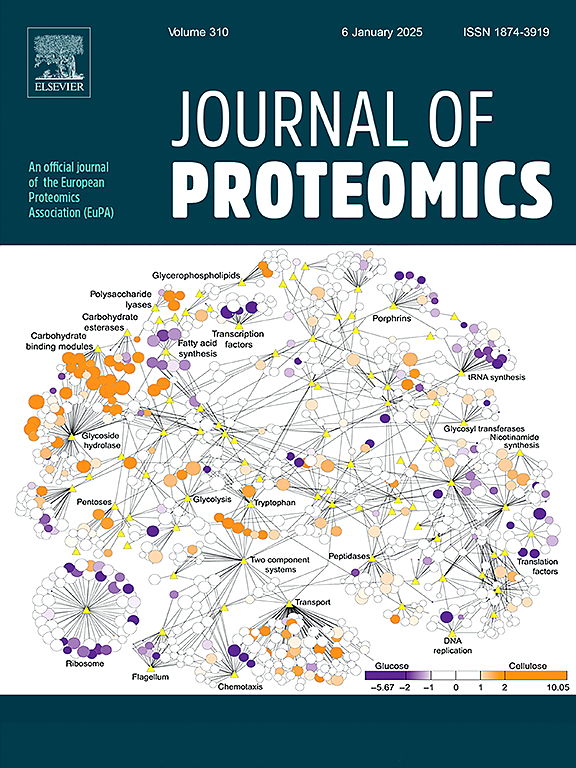Proteomic analysis of plasma-derived extracellular vesicles: Insights into acute stroke pathophysiology
IF 2.8
2区 生物学
Q2 BIOCHEMICAL RESEARCH METHODS
引用次数: 0
Abstract
Managing acute stroke is challenging and requires the differentiation of stroke subtypes while excluding stroke mimics. Understanding the biological processes underlying the different stroke subtypes could help improve acute stroke care and patient outcomes. Plasma-derived extracellular vesicles (EVs) have emerged as promising tools for investigating these processes through their unique cargo.
Therefore, we aimed at exploring the protein content of plasma-derived EVs in a cohort composed of patients with hemorrhagic stroke (n = 10), ischemic stroke with large-vessel occlusion (LVO) (n = 10) and without LVO (n = 10), transient ischemic attack (n = 10), stroke mimics (n = 10) and healthy controls (n = 10). EVs were isolated by size exclusion chromatography from 150 μL of plasma. Characterization was performed by transmission electron microscopy, western blotting and nanoparticle tracking analysis, and confirmed an efficient EV enrichment. Proteomics analysis was conducted using data-independent acquisition mass spectrometry and a supervised partial least squares discriminant analysis (PLS-DA) model was applied on proteomics data.
The PLS-DA model successfully distinguished healthy controls, severe stroke subtypes (LVO ischemic and hemorrhagic stroke), and non LVO ischemic stroke, identifying key proteins influencing these patterns. These findings suggest that EVs and their protein cargo may play a role in critical processes like inflammation and coagulation in acute stroke pathology.

血浆来源的细胞外囊泡的蛋白质组学分析:对急性中风病理生理学的见解
管理急性中风是具有挑战性的,需要区分中风亚型,同时排除中风模拟。了解不同脑卒中亚型的生物学过程有助于改善急性脑卒中护理和患者预后。血浆来源的细胞外囊泡(ev)通过其独特的货物已经成为研究这些过程的有前途的工具。因此,我们旨在探讨血浆源性EVs的蛋白质含量,该队列包括出血性卒中(n = 10)、缺血性卒中伴大血管闭塞(LVO) (n = 10)和无LVO (n = 10)、短暂性脑缺血发作(n = 10)、卒中模拟(n = 10)和健康对照(n = 10)。从150 μL的血浆中分离出ev。通过透射电镜、免疫印迹和纳米颗粒跟踪分析进行了表征,并证实了EV的高效富集。蛋白质组学分析采用数据独立获取质谱法,并对蛋白质组学数据采用监督偏最小二乘判别分析(PLS-DA)模型。PLS-DA模型成功地区分了健康对照、严重卒中亚型(LVO缺血性和出血性卒中)和非LVO缺血性卒中,并确定了影响这些模式的关键蛋白。这些发现表明,在急性脑卒中病理过程中,EVs及其蛋白载货可能在炎症和凝血等关键过程中发挥作用。
本文章由计算机程序翻译,如有差异,请以英文原文为准。
求助全文
约1分钟内获得全文
求助全文
来源期刊

Journal of proteomics
生物-生化研究方法
CiteScore
7.10
自引率
3.00%
发文量
227
审稿时长
73 days
期刊介绍:
Journal of Proteomics is aimed at protein scientists and analytical chemists in the field of proteomics, biomarker discovery, protein analytics, plant proteomics, microbial and animal proteomics, human studies, tissue imaging by mass spectrometry, non-conventional and non-model organism proteomics, and protein bioinformatics. The journal welcomes papers in new and upcoming areas such as metabolomics, genomics, systems biology, toxicogenomics, pharmacoproteomics.
Journal of Proteomics unifies both fundamental scientists and clinicians, and includes translational research. Suggestions for reviews, webinars and thematic issues are welcome.
 求助内容:
求助内容: 应助结果提醒方式:
应助结果提醒方式:


